
Key Findings:
- More than 1 in 10 people credited porn with helping to rekindle their sex life with a partner.
- People who watched porn alone and with a partner were more likely to be satisfied with their relationship than those who solely watched porn alone.
- People discussing porn with a partner were more likely to be sexually satisfied than those who hadn’t broached the topic.
- 22% of men and 13% of women had lied to a partner about their porn habits. Only 1 in 10 considered viewing porn to be cheating.
- 35% of people thought porn is somewhat or very beneficial to society, and another 23% said it is somewhat or very harmful.
- Women and people in relationships were more likely than men and single people to say porn was beneficial to their sex life.
- Compared to older groups, people in their 20s were the most likely to say porn has helped them understand what they desire sexually.
- LGBTQ participants were two times as likely as porn viewers identifying as straight to say porn helped them become more comfortable with their kinks and sexual desires.
- Those in their 20s reported watching the most porn each week – and they also were the most likely to say porn is harmful to their sex life.
- Nearly 20% of people in their 20s said porn gave them unrealistic expectations about sex.
- 9% of people in a relationship have watched porn with a partner for the first time since March 2020.
- More than 1 in 3 people have watched more porn since the Coronavirus pandemic started.
Porn is popular. Really popular. So popular, in fact, that its worldwide streaming has become an environmental problem that produces as much CO2 as Belgium. And this was before the age of quarantine. The porn industry may have been one of the few to not only survive, but thrive, during these times, and we wanted to know exactly how this played out once people were offline.
Essentially, we wanted to understand the benefits and drawbacks of porn, but what we found was much more revelatory than a pros and cons list. After comparing the intimate details of over 1,000 adults, we noticed that various demographic groups are influenced by porn in dramatically different ways. COVID-19 impacted porn consumption, but the specific ways in which it was impacted felt surprising. If porn is already part of your life, your relationship, or even your sexual identity, you’ll definitely want to read what we discovered.
Pandemic Porn
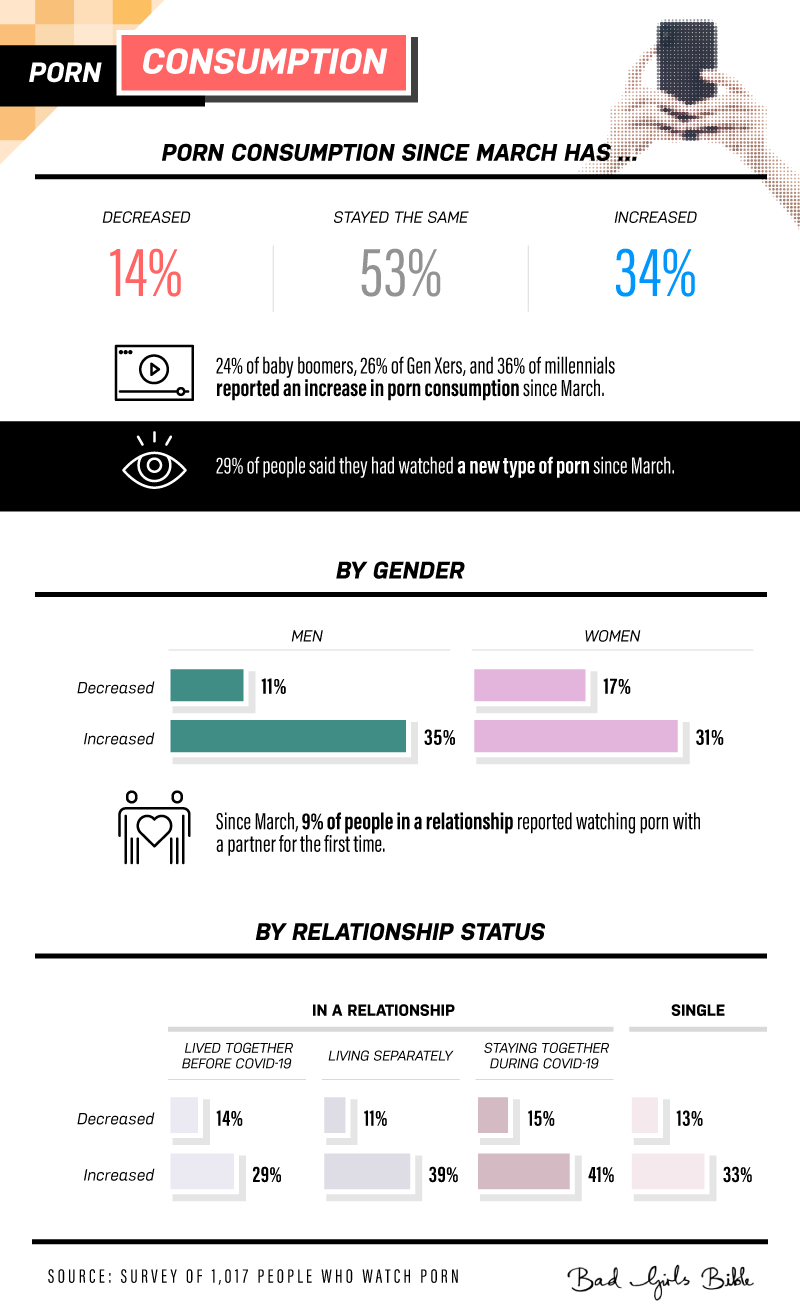
First, our study looked at how porn consumption had changed since the outbreak of the coronavirus. Since March 2020, more than a third of participants had increased their porn consumption. Though more than a quarter of all generations reported watching more porn in these times, millennials were the most likely to kick things up a notch. Another 29% of all generations even branched out into a new pornography genre. If necessity is the mother of invention, boredom may be the father of exploration.
About a third of men and women chose to watch more porn, as well, but we also saw a spike in the number of women who had chosen to abstain from porn during these stressful times. Health experts warn that chronic stress, which many say the pandemic has caused, can also be a libido killer. Perhaps the women in this study were more likely to experience this emotional component of sexual arousal.
One of the most ironic findings also surfaced here: Those who were in a relationship and staying together through COVID-19 were also the most likely to start increasing their porn consumption. Because respondents did not have to specify whether or not this additional porn was viewed together, we know their increased porn consumption can mean one of two things: Either the couple’s sex life utilised porn together to boost their quarantine sex life, or there was an increased desire to be alone (and to be turned on alone).
Popular Porn Opinions
Even though many journalists lump the increase in porn consumption during the pandemic with other habits, like excessive smoking and eating, the public seemed to think porn was a great idea, especially for those in higher age groups. While 49.5% of people found pornography to be beneficial to their sex life, this number jumped to 53.2% for people in their 40s and 60.8% for people aged 50 and older.
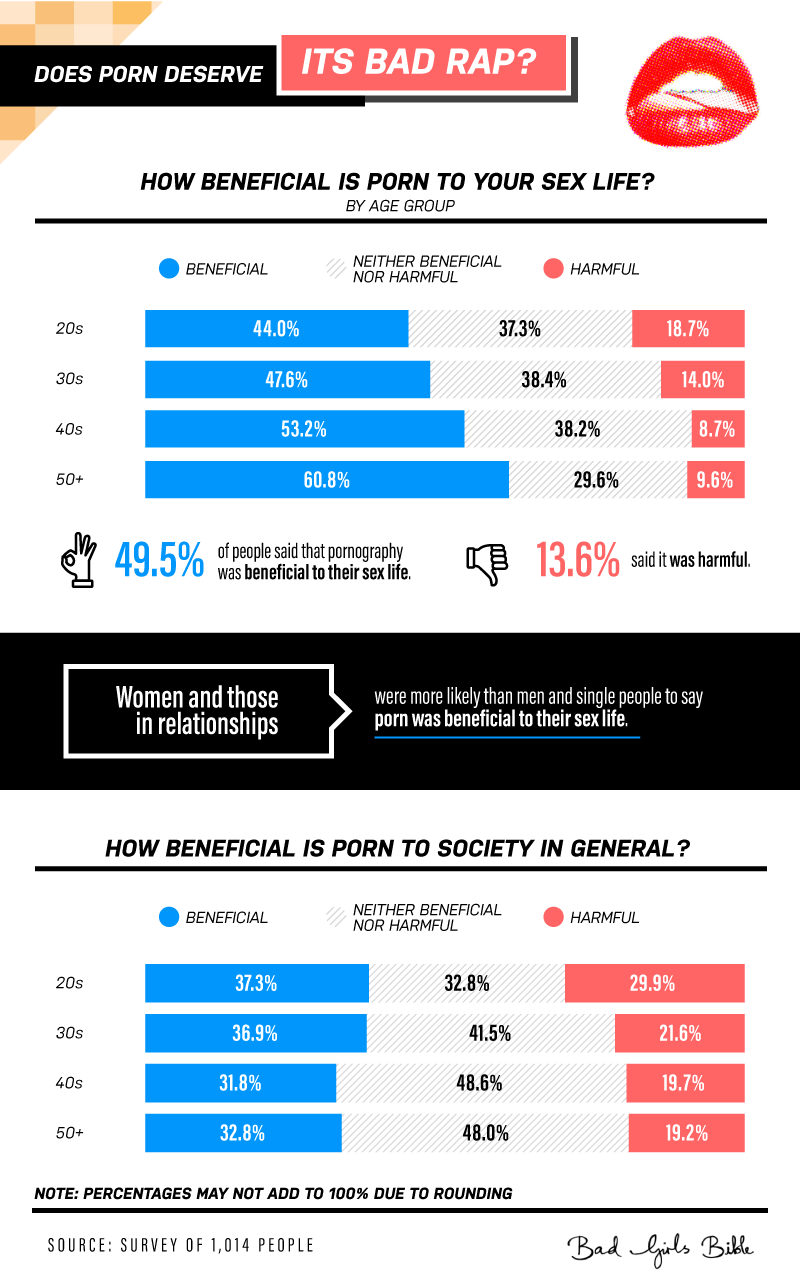
Twenty-somethings were the most likely to view porn as harmful. Because respondents’ answers might not have exclusively reflected digital porn, perhaps this age group’s opinion of the industry has been influenced by the type of porn they grew up on: digital, as opposed to print magazines. Nearly two-thirds of people aged 13-24 view porn at least once a week, and internet porn is almost always at our fingertips: a popular porn site reported that 61% of its visits were via smartphone.
Women and those in relationships were more likely than men and single people to say porn benefited their sex life. Interestingly, these two groups (women and people in relationships) also spent comparatively less time each week watching porn.
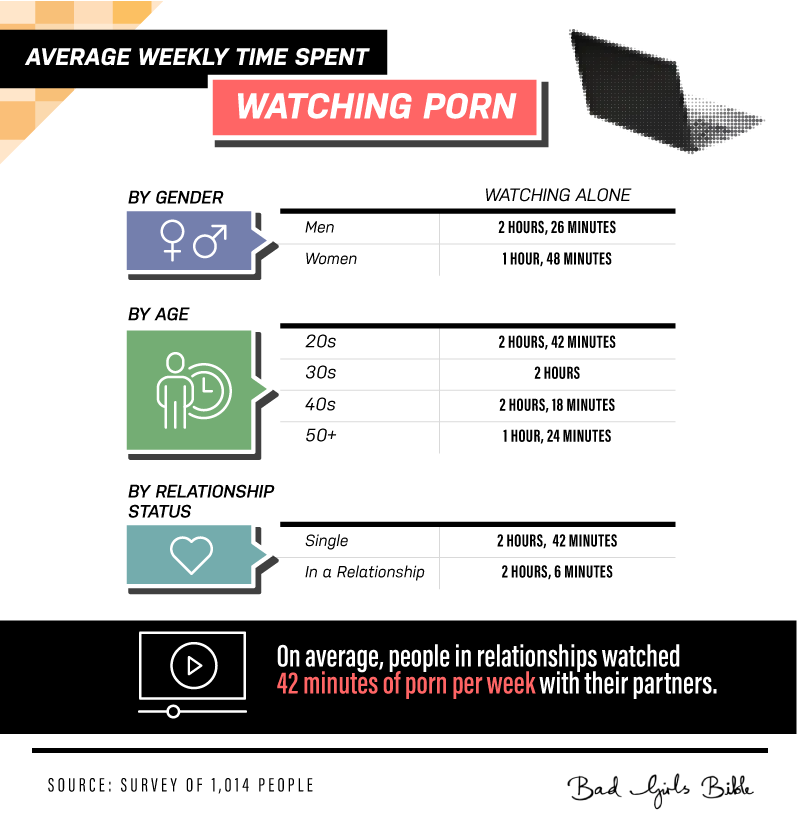
In other words, perhaps the key to receiving benefits from porn is enjoying it in moderation. Nevertheless, less than 30% of every age group felt porn was harmful to society, and every demographic watched porn for more than an hour each week, on average! But this was before the pandemic.
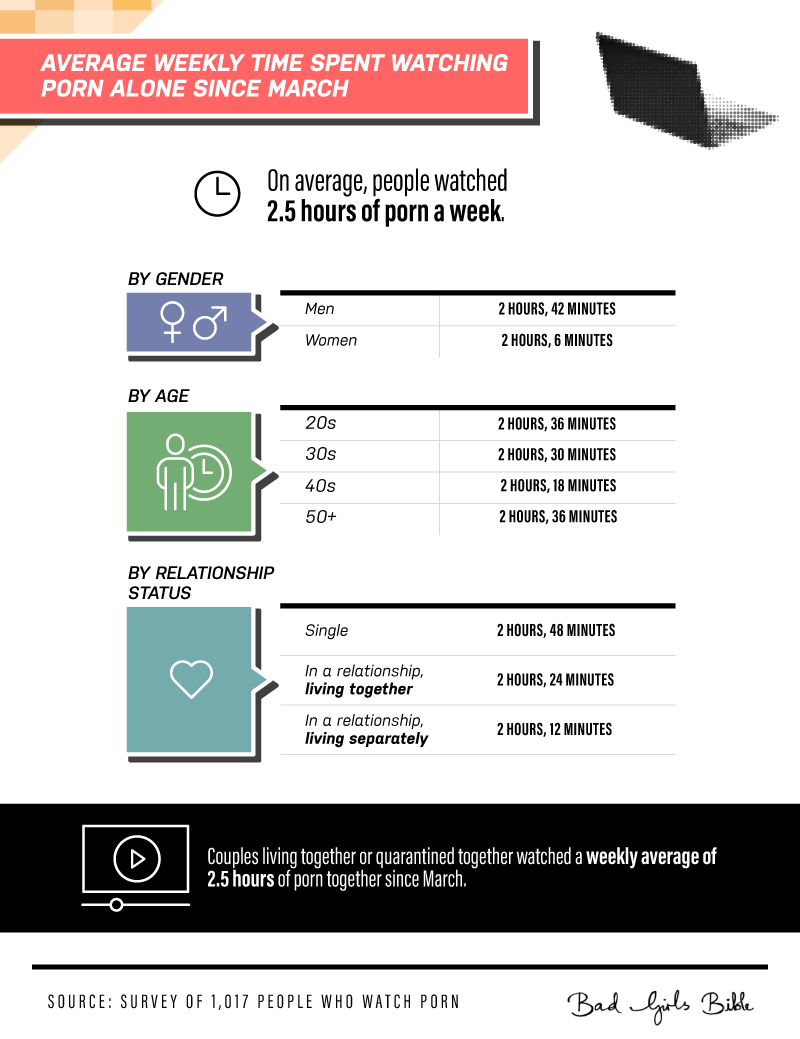
Evidently, moderation went out the window along with a social life and normalcy. Since the coronavirus, the amount of porn people watch has more than doubled. On average, respondents reported watching two and a half hours of porn every single week while in isolation.
A few key demographics were primarily responsible for such a substantial increase in porn consumption: In quarantine, men were watching an average of two hours and 42 minutes each week, topped only by single people in general (two hours and 48 minutes, on average). Those who were single also increased their porn consumption the most – without a dating life or ability to make an intimate connection in real life, porn may start to look like an appealing temporary substitute.
Why Watch Porn?
Sexual inspiration or ideas was the most reported benefit of porn. With the ability to browse an exhaustive list of categories, themes, and videos, 63.9% of 20-somethings got new ideas from watching porn, with more than half of all age groups citing this benefit as well.
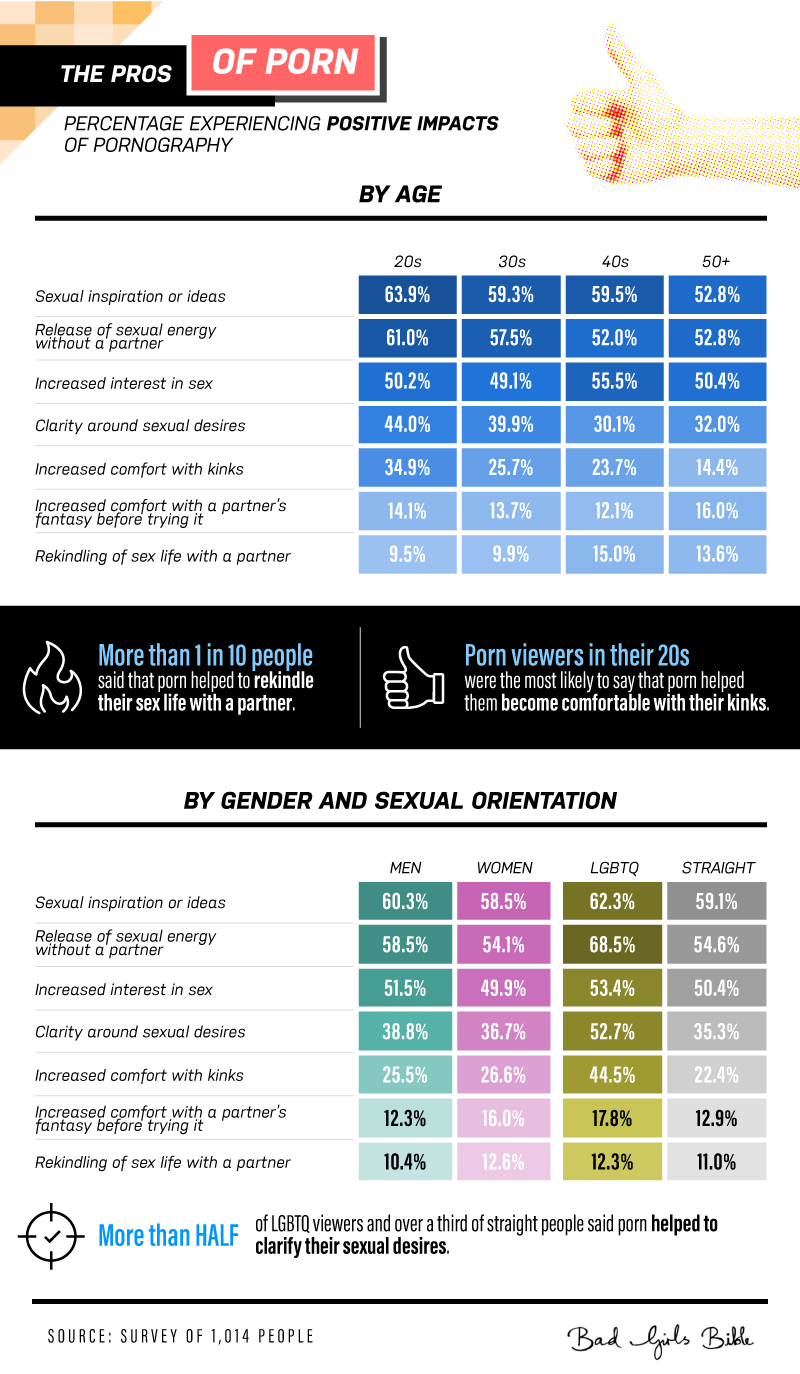
Whether respondents were watching porn in moderation or excessively, there were some commonly noted benefits our study dug into. Release of sexual energy was a commonly reported benefit. Nearly 59% of men said porn offered a channel to release sexual energy without a partner. This release is thought to be a great stress reliever too, as another study by Carnegie Mellon University revealed that men who had flipped through pictures of naked women cut their cortisol levels in half. Not only that, but the same men were able to perform better on a math test after viewing pornographic images.
The group that seemed to benefit from pornography more than others, however, was the LGBTQ community. In the words of 52.7% of this demographic, porn helped to clarify their sexual desires. As porn becomes more and more representative and realistic in terms of its portrayal of lesbian, gay, and transgender sexual experiences, it may pave the way for others to gain an understanding of their sexual interests and identity.
Consequences of Porn
Now that we’ve explored porn’s upsides, we would be remiss if we didn’t discuss the negative impacts of watching porn. A 2014 study found that those who watch porn more frequently have less functional connectivity between regions of the brain, and watching even three hours of porn each week (which some of our respondents admitted to consuming) can cause noticeable reductions in gray matter in key areas of the brain that affect behaviour and mood.
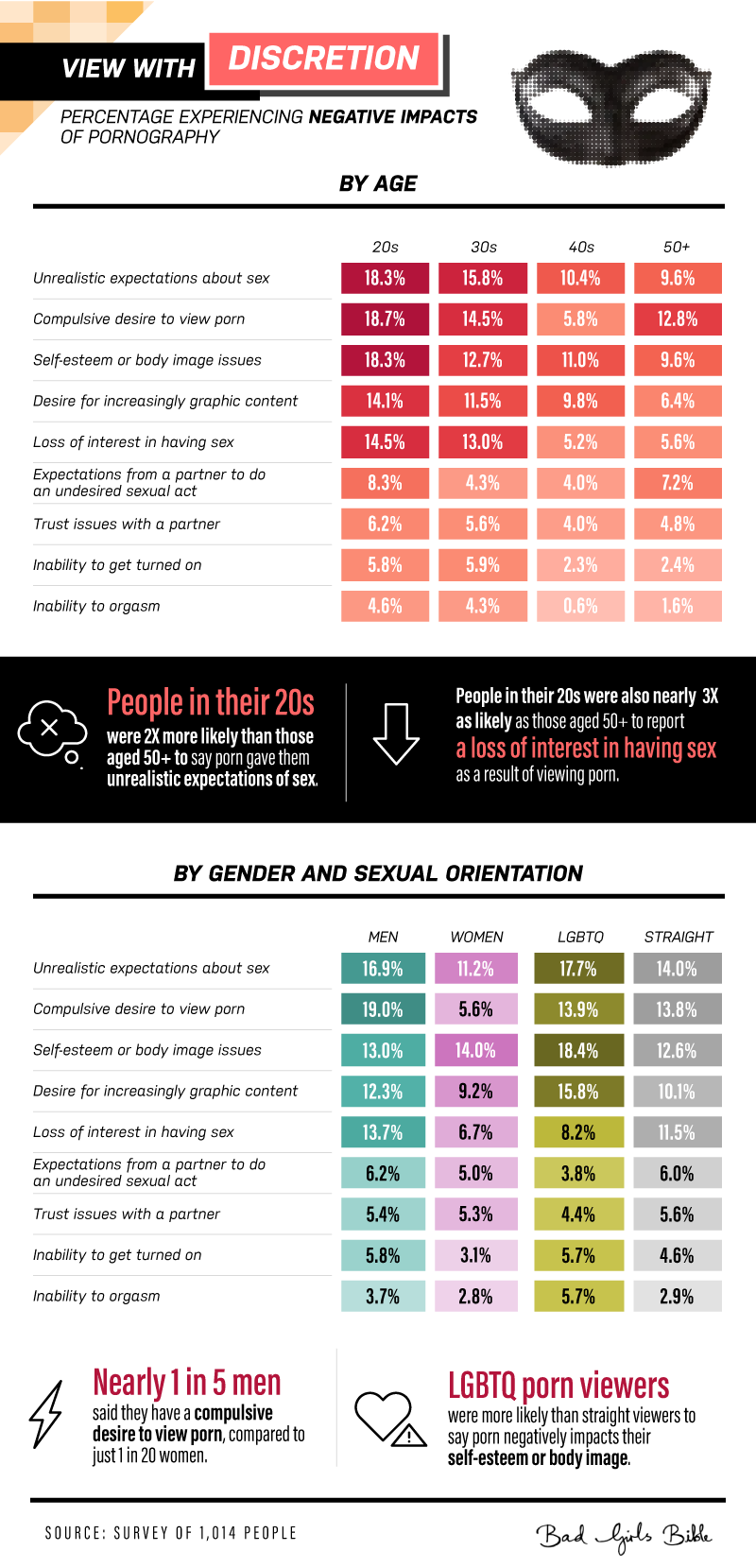
But what did our respondents have to add? To start, around 18% of viewers in their 20s said porn gave them unrealistic expectations about sex. As actress Jameela Jamil said, “Learning to have sex from pornography is like learning how to drive from ‘The Fast and the Furious.’ A terrible idea.” A compulsive desire to watch porn and self-esteem issues were also commonly reported by this young age group.
A compulsive desire to watch porn was also more common among men. Nineteen percent of this group said they were concerned about their tendencies. It’s worth noting that the Diagnostic and Statistical Manual of Mental Disorders (DSM) does not recognize porn addiction as an official mental health diagnosis, yet male respondents were consistent in their description of compulsive behavior. According to Healthline, your viewing habits may be of “concern if you:
- find that the amount of time you spend watching porn keeps growing
- feel as though you need a porn ‘fix’ – and that fix gives you a ‘high’
- feel guilty about the consequences of viewing porn
- spend hours on end perusing online porn sites, even if it means neglecting responsibilities or sleep
- insist that your romantic or sexual partner views porn or acts out porn fantasies even though they don’t want to
- are unable to enjoy sex without first viewing porn
- are unable to resist porn even though it’s disrupting your life.”
So, while porn has benefits, issues can also arise for some viewers. Remember, there is nothing shameful or wrong about seeking support from a mental health professional if you have questions about your porn consumption habits or your sexuality in general.
Pandemic Pace

Though we established porn consumption had risen during the coronavirus pandemic, we wanted to narrow in on one clear form of impact: sexual frequency. In other words, were the people in quarantine (who were generally watching more porn) also having more sex? In short, the answer is no. Only 35% of the respondents in relationships had started to have more sex since coronavirus moved everyone indoors. The vast majority of relationships saw either no change in their sex life or less sex.
Watching porn together, however, did show promise. Those who watched both, porn alone and with a partner, were slightly more likely to have more sex during these times. Those who watched porn exclusively with their partner were even more likely to see an uptick in sexual frequency.
Crossing the Line
In addition to the aforementioned issues, couples who introduced pornography into their relationships also experienced a few drawbacks, especially when honest and open communication was forsaken. Twenty-two percent of men had lied to their partner about how much porn they watched, and 12.9% of women said the same.
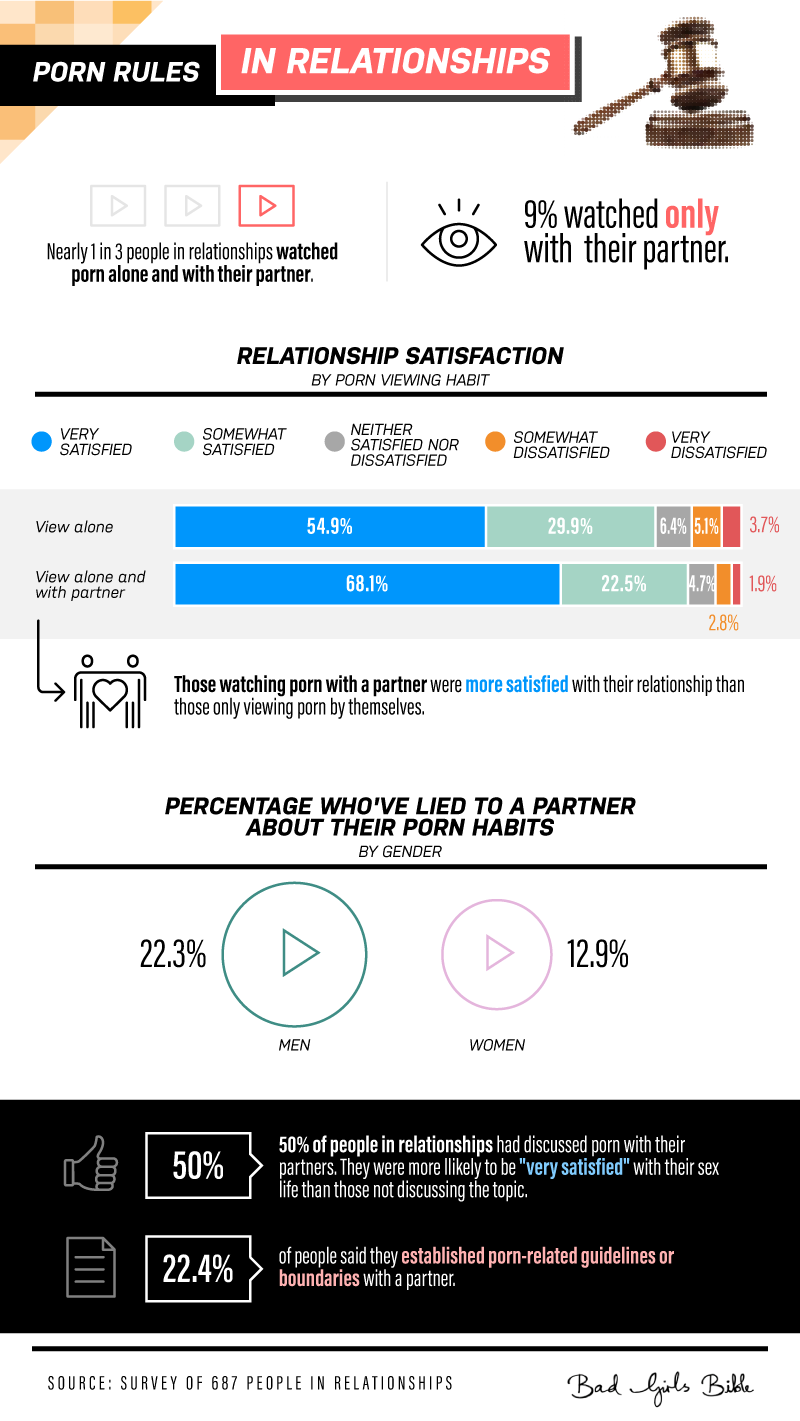
However, openness about pornography seemed to benefit couples. According to our results, 68% of those who watched porn together were still very satisfied with their relationship, and those who discussed pornography with their partners were more likely to be satisfied with their sex lives than those who did not. If it feels right for you and your relationship, consider setting guidelines and boundaries around porn, as 22.4% of respondents did. Some examples of guidelines we heard were:
- “Don’t choose watching porn over having sex with each other.” — 35-year-old woman
- “Don’t ask, don’t tell.” — 26-year-old woman
- “I view porn really rarely, and it’s basically to get something really specific. He has chosen not to watch porn because it isn’t good for him, and I support him in that as an accountability partner.” — 31-year-old woman
- “No one-on-one cam sessions.” — 42-year-old woman
Feeling Positive About Pornography
Ultimately, our data revealed that pornography can be more than just sexual – it can be educational, stress-relieving, and even inspirational. Respondents, by and large, enjoyed it and felt they stood to learn something from it. They were thankfully willing to share intimate details of their sex life with their partner, as well as their solo behaviour, giving us a data-backed view of how pornography looks in the average American life.
And if there’s anyone who’s a proponent of useful sexual talk, education, and inspiration, it’s the Bad Girls Bible. The Bad Girls Bible is your guide to intense sex, more orgasms, and a deeply passionate relationship, with yourself or various partners. If you’re interested in improving your sexual skills and understanding how to please your partner, head over to BadGirlsBible.com today.
Methodology
We ran two surveys using a web-based survey form for this project. The first survey on general porn habits and attitudes was among 1,014 people. Ninety-three per cent of them viewed porn, and 7% did not view porn. Among those who viewed porn, 44.9% viewed it more than once a week, 26.8% viewed it a few times a month, 7.3% viewed it once per month, and 14% viewed porn less than once a month.
57.6% of participants were men, 41.8% were women, and 0.6% were nonbinary. 84.1% of participants were straight, and 15.9% were lesbian, gay, bisexual, transgender, nonbinary, or queer (161 participants). 72.9% of participants were in a relationship, and 27.1% were single.
Participants ranged in age from 18 to 78 with a mean of 37.5 and a standard deviation of 11.6. Participants were notified that the study contained sensitive and sexually explicit material before they could opt in.
For the second survey related to porn consumption habits during the COVID-19 pandemic, we surveyed 1,017 people who said they had watched porn since March 2020. Of these people, 49.7% said they watched porn more than once a week, 30.9% said they watched porn a few times a month, 10.4% said they watched porn once per month, and 9.1% said they watched porn less than once a month.
63.3% of our respondents were men, 36.2% were women, and 0.5% were nonbinary. 66.1% were in a relationship, and 33.9% were single.
Participants in this survey ranged in age from 18 to 78, with a mean of 35.6 and a standard deviation of 11.1. Participants were notified that the study contained sensitive and sexually explicit material before they could opt in.
Limitations
We excluded outliers in the numerical data. Responses were not weighted nor statistically tested and are based on self-report and subject to inherent issues such as telescoping and recency bias. This study is based on means alone and is purely exploratory. The average pornography consumption times and attitudes of pornography were collected with a different sampling of respondents than the visuals related to COVID-19.
Fair Use Statement
Surprised by some of our pornography consumption findings? Feel free to share this with anybody who you think may benefit, but be sure the use is noncommercial and to link back to this page to provide proper credit.

Leave a Reply